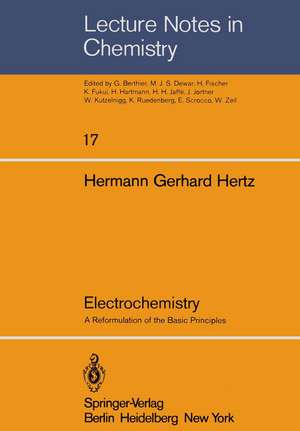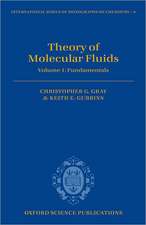Electrochemistry: A Reformulation of the Basic Principles: Lecture Notes in Chemistry, cartea 17
Editat de H. G. Hertzen Limba Engleză Paperback – iun 1980
Din seria Lecture Notes in Chemistry
-
 Preț: 96.74 lei
Preț: 96.74 lei - 18%
 Preț: 1123.35 lei
Preț: 1123.35 lei - 18%
 Preț: 776.72 lei
Preț: 776.72 lei - 18%
 Preț: 779.57 lei
Preț: 779.57 lei - 18%
 Preț: 1005.74 lei
Preț: 1005.74 lei - 18%
 Preț: 997.88 lei
Preț: 997.88 lei - 18%
 Preț: 1004.00 lei
Preț: 1004.00 lei - 18%
 Preț: 1136.30 lei
Preț: 1136.30 lei - 18%
 Preț: 1117.03 lei
Preț: 1117.03 lei - 18%
 Preț: 1006.55 lei
Preț: 1006.55 lei - 18%
 Preț: 903.62 lei
Preț: 903.62 lei -
 Preț: 377.73 lei
Preț: 377.73 lei -
 Preț: 395.63 lei
Preț: 395.63 lei - 18%
 Preț: 728.43 lei
Preț: 728.43 lei - 18%
 Preț: 782.57 lei
Preț: 782.57 lei - 18%
 Preț: 1112.78 lei
Preț: 1112.78 lei - 15%
 Preț: 688.13 lei
Preț: 688.13 lei - 15%
 Preț: 646.62 lei
Preț: 646.62 lei -
 Preț: 393.35 lei
Preț: 393.35 lei - 18%
 Preț: 1124.30 lei
Preț: 1124.30 lei -
 Preț: 384.86 lei
Preț: 384.86 lei -
 Preț: 383.71 lei
Preț: 383.71 lei -
 Preț: 378.71 lei
Preț: 378.71 lei -
 Preț: 384.09 lei
Preț: 384.09 lei -
 Preț: 387.42 lei
Preț: 387.42 lei -
 Preț: 393.35 lei
Preț: 393.35 lei -
 Preț: 384.09 lei
Preț: 384.09 lei -
 Preț: 377.73 lei
Preț: 377.73 lei -
 Preț: 382.95 lei
Preț: 382.95 lei -
 Preț: 384.70 lei
Preț: 384.70 lei - 15%
 Preț: 644.63 lei
Preț: 644.63 lei -
 Preț: 386.00 lei
Preț: 386.00 lei -
 Preț: 389.70 lei
Preț: 389.70 lei -
 Preț: 384.09 lei
Preț: 384.09 lei -
 Preț: 385.25 lei
Preț: 385.25 lei -
 Preț: 392.21 lei
Preț: 392.21 lei -
 Preț: 386.00 lei
Preț: 386.00 lei -
 Preț: 403.37 lei
Preț: 403.37 lei -
 Preț: 378.71 lei
Preț: 378.71 lei -
 Preț: 383.50 lei
Preț: 383.50 lei -
 Preț: 390.63 lei
Preț: 390.63 lei -
 Preț: 389.31 lei
Preț: 389.31 lei
Preț: 388.90 lei
Nou
Puncte Express: 583
Preț estimativ în valută:
74.41€ • 77.90$ • 61.57£
74.41€ • 77.90$ • 61.57£
Carte tipărită la comandă
Livrare economică 05-19 aprilie
Preluare comenzi: 021 569.72.76
Specificații
ISBN-13: 9783540100089
ISBN-10: 3540100083
Pagini: 272
Ilustrații: X, 257 p.
Dimensiuni: 170 x 244 x 14 mm
Greutate: 0.44 kg
Editura: Springer Berlin, Heidelberg
Colecția Springer
Seria Lecture Notes in Chemistry
Locul publicării:Berlin, Heidelberg, Germany
ISBN-10: 3540100083
Pagini: 272
Ilustrații: X, 257 p.
Dimensiuni: 170 x 244 x 14 mm
Greutate: 0.44 kg
Editura: Springer Berlin, Heidelberg
Colecția Springer
Seria Lecture Notes in Chemistry
Locul publicării:Berlin, Heidelberg, Germany
Public țintă
ResearchCuprins
1: Description of the multicomponent electrolyte solution in the equilibrium state.- 1.1 Components, constituents, salt molecules and ions.- 1.2 Coordinate system transformations.- 1.3 The chemical potentials.- 2: The multicomponent electrolyte solution in the non-equilibrium situation.- 2.1 The local mass conservation in a non-equilibrium system.- 2.2 Description of the diffusion process in a multicomponent electrolyte solution.- 2.3 Description of multicomponent electrolyte diffusion in various property spaces.- 3: The diffusion system in the presence of an electric current.- 3.1 Local rates of change of composition in the presence of an electric current.- 3.2 Excess constituent mass fluxes and generalized transport numbers.- 3.3 The delocalized conservation of mass.- 3.4 A prototype of a galvanic cell.- 3.5 The conventional transport numbers.- 3.6 The fundamental equations of electrochemistry.- 3.7 A comparison of the use of generalized and conventional transport numbers.- 4: The moving boundary method.- 4.1 The experimental determination of transport numbers.- 4.2 The self-regulating mechanism of the moving boundary.- 5: The diffusion process at the electrode in the presence of an electric current.- 5.1 Mass fluxes and excess mass fluxes at a metal electrode.- 5.2 The Hittorf method to measure transport numbers.- 5.3 Electrodes of the second kind.- 5.4 The fluxes at the redox electrode.- 5.5 Mass production at the liquid junction.- 6: Energy changes in electrochemical systems.- 6.1 Rate of internal energy change of a homogeneus system.- 6.2 Rate of internal energy change in a normal non-uniform system.- 6.3 Energy and momentum changes in the presence of an electric current.- 6.4 “Complete” and “truncated” systems.- 6.5 The reversible electric work and the electromotive force.- 7: A comparison of our electrolyte diffusion treatment with the conventional one.- 7.1 A brief summary; Electric current density and mass flux in our theory.- 7.2 Treatment of the electriccurrent density in the conventional theory.- 7.3 Transport numbers in the conventional treatment.- 7.4 The mass flux in the conventional treatment.- 7.5 Summary of comparison between the two approaches.- 8: The electromotive force of a galvanic cell.- 8.1 The cell Na/NaI/KCl/Cl2, some general outlines.- 8.2 The cell Na/Nal/KCl/Cl2, explicit formulas for the electromotive force.- 8.3 Consideration of a more general case: The galvanic cell Na/NaCl(a), NaI(a), KCl(a)/NaCl(c), NaI(c), KCl(c)/Cl2.- 8.4 Coordinate system transformations.- 8.5 Simplifications by introduction of suitable approximations.- 8.6 Treatment of the galvanic cell in which the electrolyte has arbitrary composition, but the cathode is an I2-electrode, Na/NaCl(a), NaI(a), KCl(a)/NaCl(c), NaI(c), KCl(c)/I2.- 8.7 A comparison: The conventional treatment of the galvanic cell.- 9: Galvanic cells containing only one type of anion (or correspondingly, one type of cation).- 9.1 The cell configuration $$Na/Q_{NaCl}^{(a)},Q_{KCl}^{(a)},Q_{NaCl}^{(c)},Q_{KCl}^{(c)}/C{l_2}$$.- 9.2 The galvanic cell $$Na/Q_{NaCl}^{(a)},Q_{KCl}^{(a)},Q_{NaCl}^{(c)},Q_{KCl}^{(c)}/K$$.- 9.3 The galvanic cell in which one of the constituents is given by a polyvalent cation.- 9.4 The cell which contains only one kind of binary electrolyte solution, but with varying concentration.- 9.5 The concentration cell with transference.- 10:The galvanic cell with a redox electrode.- 10.1 Consideration of a special case.- 10.2 Modification of the galvanic cell involving a redox reaction.- 11: The galvanic cell with an oxygen electrode.- 11.1 The anode is a Na electrode.- 11.2 A cell with a chlorine and an oxygen electrode.- 11.3 The replacement of the oxygen electrode by a hydrogen electrode.- 12: The salt bridge.- 12.1 General.- 12.2. KCl-salt bridge connecting two chloride solutions.- 12.3 The general case of a salt bridge application.- 12.4 Replacement of the KCl-salt bridge by NaCl- and NaNO3-salt bridges.- 12.5 Another example: The KCl-saltbridge is placed between a NaI and an HCl solution.- 12.6 The salt bridge (KCl) between a redox electrode and a hydrogen electrode.- 12.7 The physical reason for the effectiveness of the salt bridge — an estimate of component concentration in the salt-bridge boundary.- 13: Membrane potentials.- 13.1 Simple membrane arrangements.- 13.2 The Donnan potential.- 13.3 The glass electrode.- Acknowledgement.













